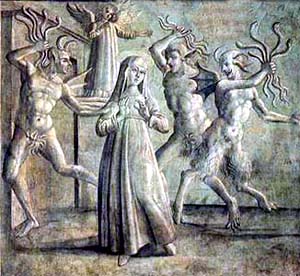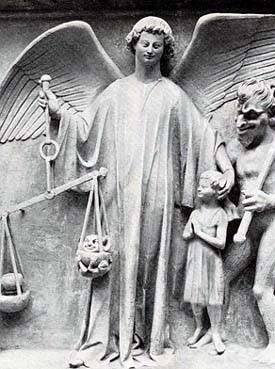 |
The Saint of the Day
St. Frances of Rome, March 9
Prof. Plinio Corrêa de Oliveira
Biographical selection:
Born 1384 in Rome, died 1440 in Rome. St. Frances of Rome received a supernatural gift of visions from God. She is famous for her visions about Hell. Perhaps throughout the History of the Church no other mystic has had so many descriptive visions of Hell as St. Frances.
The following text is taken from Rohrbaher, Universal History of the Catholic Church. The author reproduces words of the Saint regarding one of her visions on Hell:

St. Frances of Rome, protected by her guardian angel, sees the devils who tempt men on earth
|
While one-third of the angels sinned, the other two-thirds persevered in grace. One-third of the fallen angels are in Hell tormenting the condemned souls. These devils are the ones who freely followed Lucifer and deliberately revolted against God. They cannot leave the abyss except with the special acquiescence of God, when He decides to punish the sins of men with a great calamity. These are the worst among the devils.
The other two-thirds of the fallen angels inhabit the air and the earth. They are the ones who did not take a side in the battle between Lucifer and God, but remained silent.
The devils of the air often instigate storms, winds and thunders to frighten souls, causing their wills to weaken and cede to inconstancy, thus preparing them to falter in the Faith and to doubt Divine Providence. The devils who live on earth among men to tempt us are the fallen angels of the lowest choir. The faithful angels of this choir are our guardian angels.
The prince and chief of all devils is Lucifer, who is confined at the bottom of the abyss, where he punishes the other devils and the condemned men and women. Since he fell from the highest place among the angels, the Seraphic choir, he became the worst devil. His characteristic vice is pride.
Below him and under his power are three other princes: First, Asmodeu, who represents the vice of impurity and was the head of the Cherubim; second, Mammon, who represents the vice of avarice and was the first among the Thrones; third, Belzebuth, who represents idolatry, sorcery and spells and was the chief of the Dominations. He is over everything that is dark and that diffuses darkness over rational creatures.
Comments of Prof. Plinio:
St. Frances of Rome describes Lucifer as the highest Seraphim, and for this reason his sin was very grave. You know that the Seraphim constitute the highest of the nine choirs of angels. Since he was the highest angel in Heaven who revolted, he was thrown into the deepest part of Hell.

Lucifer torments the worst souls condemned to Hell
|
There were angels who made the decision to follow Lucifer with a special malice and by their own initiative. These went to Hell with him and are being tormented by him since he is more powerful than they, and because Divine Justice delegated him the task of punishing for all eternity those whom he had convinced to follow him in the rebellion.
After that, St. Frances tells us, there are three principal demons who follow Lucifer’s commands. The first is Asmodeu, who represents the vice of the flesh; the second is Mammon, head of the vice of avarice, and then Belzebuth, chief of all idolatries and dark works.
You are seeing that the two principal rebellious angels – Lucifer and Asmodeu – are the angels of pride and sensuality. According to our conception of History, pride and sensuality are the two driving forces of the Revolution. In a certain sense, this description of St. Frances confirms it. These angels are in Hell and only rarely does God permit them to leave the abyss to punish humanity. I have the impression that in our times Hell was opened and these worst of devils are on earth trying to accomplish the special task of destroying the Church, just as they were also on earth to kill Our Lord Jesus Christ. I know that the Catholic Church is immortal, but I think that in our days they are here to try
to destroy her.
Then there are the other fallen angels. In the first battle they did not want to choose between God and Lucifer. They did not revolt outright against God nor did they clearly support His cause. At the same time, they did not give straightforward support to the cause of Lucifer. They remained in the middle of the road, in a neutral position, which at depth meant they had sympathy for Satan. It was for this reason that God condemned them. But Divine Justice made their chastisement less terrible than that of the other angels. Instead of being hurled into Hell, they are in the air and on the earth. After the Final Judgment they will go to Hell for all eternity. Therefore, during this time between their
sin and the Final Judgment, they escape the suffering of Hell.

The devils of the earth tempt the souls, while the guardian angels protect them
|
These “middle-of-the-road” angels are divided into two kinds. First, there are the angels who inhabit the air and produce climatic turmoil to frighten men on earth. Second, there are the angels on earth who belong to the same choir as our guardian angels. They normally do the opposite of the guardian angels, that is, instead of protecting persons, they try to lead them into the danger of sin. There is a constant battle between these two kinds of angels.
From this, we can learn an important lesson. It is to realize how small man is. How minute we are compared to the magnitude of the angelical nature. There was a Saint who often saw her guardian angel, that is, an angel from the lowest choir in the celestial hierarchy. Well, the first time she saw him she was so impressed with the appearance of the angel that she thought he was God Himself. She fell prostrate to the ground to adore him. He had to stop her and explain who he was. This shows us the splendor of a simple guardian angel. Can you imagine, then, the splendor of an Archangel, and even more, of a Cherubim or a Seraphim?
How small we are in face of this battle among the angels that is taking place around us everywhere and all the time! There are angels who come down from Heaven with this or that mission. There are devils who come out of Hell to cause a great damage. There are demons who infest the air, demons who are working among men. Really we are very small in face of this angelic struggle.
What is our defense against all the plots and evil instigated by these devils? We need to apply the warning of Our Lord: be vigilant and pray in order not to fall into temptation. And the beginning of this vigilance is to believe in the angelical presence, its power, and its continual action.
A Bishop once taught me a principle that is currently admitted among theologians. It is that in any natural temptation a man has, the devil adds his action to the natural cause to make the temptation more intense. For instance, suppose that one of you feels irritated by someone who is bothering you in this crowded meeting. This small temptation toward irritation receives a new impulse from the devil, who tries to increase the natural irritation and induce one to sin.
The devil is always acting against us; the guardian angels are always protecting us. We should try to discern the action of the devils and ask the protection of our guardian angels more often. We should also pray to Our Lady more often. This is to be vigilant against the action of the devils.
This is the lesson I suggest to you from this revelation of St. Frances of Rome.


  | | Prof. Plinio Corrêa de Oliveira | |
The Saint of the Day features highlights from the lives of saints based on comments made by the late Prof. Plinio Corrêa de Oliveira. Following the example of St. John Bosco who used to make similar talks for the boys of his College, each evening it was Prof. Plinio’s custom to make a short commentary on the lives of the next day’s saint in a meeting for youth in order to encourage them in the practice of virtue and love for the Catholic Church. TIA thought that its readers could profit from these valuable commentaries.
The texts of both the biographical data and the comments come from personal notes taken by Atila S. Guimarães from 1964 to 1995. Given the fact that the source is a personal notebook, it is possible that at times the biographic notes transcribed here will not rigorously follow the original text read by Prof. Plinio. The commentaries have also been adapted and translated for TIA’s site.
|
Saint of the Day | Home | Books | CDs | Search | Contact Us | Donate

© 2002- Tradition in Action, Inc. All Rights Reserved
|
 |
|